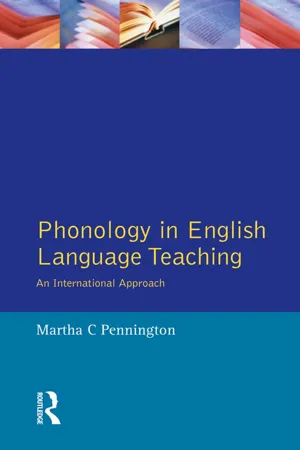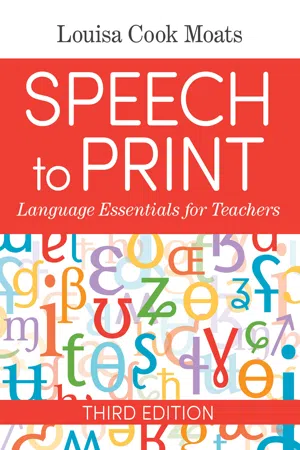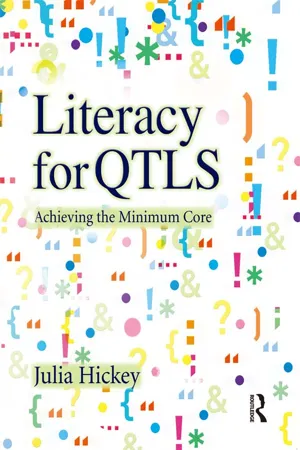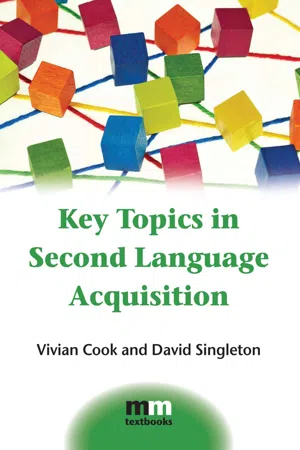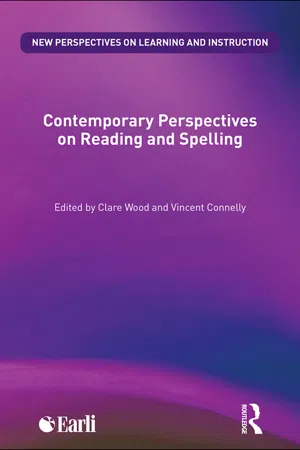Languages & Linguistics
Spelling
Spelling refers to the correct arrangement of letters in a word according to established conventions. It involves understanding the relationship between sounds and letters in a language and applying rules for forming words. Spelling is an essential aspect of written communication and is important for conveying meaning accurately.
Written by Perlego with AI-assistance
Related key terms
8 Key excerpts on "Spelling"
- eBook - ePub
- Judith R. Birsh, Suzanne Carreker, Judith R. Birsh, Suzanne Carreker(Authors)
- 2018(Publication Date)
- Brookes Publishing(Publisher)
The teacher must assume an active role in Spelling instruction. As Moats stated, “Rather than a developmental progression characterized by distinct stages, learning to spell is more accurately described as a continual amalgamation of phonological, morphological, and orthographic knowledge” (2005, p. 14). It is imperative that the teacher have and be able to impart knowledge about the sounds of the language, the most frequent and reliable letter patterns and rules of English orthography, morphology, and word origins to help students consolidate their knowledge of language structures into correct Spellings (Brady & Moats, 1997; Joshi & Carreker, 2009; see Chapter 14 for a discussion of English word origins). Phonology Phonetics is the study of the characteristics of individual speech sounds (i.e., phonemes) that occur in all languages (see Scarborough & Brady, 2002, for a discussion about related phon terms; these are also addressed in Chapter 6). There are approximately 44 speech sounds in English, with some variants of these sounds (i.e., allophones) that are not considered separate speech sounds (e.g., the /ă/ in the word sank is different from the /ă/ in sack but is not a separate speech sound). Phonetics involves categorizing or describing the articulation of each speech sound—where the sound is produced, the way in which air stream flows through the mouth and nose, and the activity of the vocal cords during production. Spoken words are made up of the speech sounds. Every language has its own set of rules that governs the utterance of these sounds and the sound patterns that are allowed. This system of rules that determine how sounds are used in spoken language is called phonology (Moats, 1995) - eBook - ePub
- Eve Bearne(Author)
- 2003(Publication Date)
- Routledge(Publisher)
Until recently, Spelling has been a relatively unquestioned part of the curriculum. It was enough to know that everyone should be able to do it. But in a recent book on creativity, control and Spelling, Gunther Kress begins by asking: What is Spelling? An easy answer might be ‘to match the sound of a word in spoken language to the look of a word in written language’. However, Kress provocatively suggests:He continues:If Spelling is simply a matter of reproducing, correctly, the remembered sequence of letters that make a written word, then all this stuff about the relation to the sound of language is quite beside the point.(Kress 2000: 1)In English we seem to be stuck with the typical compromise: yes, Spelling is a matter of the look of words; yes, there is visual Spelling; and yes, Spelling is a matter of the relation of speech to writing, a question of getting the right letter sequences to capture the sound of the language. The rules of Spelling promise to provide a reliable means of getting from the sound of language to the look of language in terms of sequence of letter shapes. This ignores an uncomfortable fact, however; the rules of Spelling do not start from sound and guide you to writing; rather, they start from writing and guide you [should you wish to be guided in that direction] to the pronunciation of letter sequences in sound.(Kress 2000: 1)Learning to spell through learning to write raises issues about early instruction in writing, reading and Spelling – particularly since the introduction of the National Literacy Strategy – teaching Spelling has been associated mostly with teaching reading. Concerns about opportunities for sustained writing become even more significant if Spelling is best developed through writing experiments and experience.Spelling development
Much of the more recent longitudinal research into Spelling development reinforces the importance of teaching Spelling as part of writing rather than largely associated with reading (O’ Sullivan and Thomas, CLPE 2000; Department of Education, Western Australia 1997). The CLPE research was influenced by the work of Uta Frith who describes both reading and Spelling as following a move from the logographic [whole word], stage to the analytic [alphabetic] and finally the orthographic [conventional] (Frith 1980). - eBook - ePub
Phonology in English Language Teaching
An International Approach
- Martha C. Pennington(Author)
- 2014(Publication Date)
- Routledge(Publisher)
morphophonemic.If we look at relatively small subsets of the English lexicon, we can find many phonological regularities which are not indicated orthographically but which are nevertheless predictable for that set of words. For example, a regular pattern of alternation of long or tense and short or lax vowels is seen when endings are added to stems, as in the following sets of pairs (each of which could be expanded to a longer list):a /e:/ nation /æ/ national ration rational /e:/ sage /ə/ sagacious able ability i /aɪ/ hide /ɪ/ hidden ride ridden bite bitten wide width o /o:/ phone /ɑ/ phonic cone conic melody melodic photo photography As in the examples for vowels given above, it can be said that “the conventional Spelling of words corresponds more closely to an underlying abstract level of representation within the sound system of the language, [sic] than it does to the surface phonetic form that the words assume in the spoken language” (C. Chomsky 1970: 288). The orthographic patterns of English in such items may make reading more efficient since the reader is led to ignore phonetic detail in favor of semantic relationships among words (C. Chomsky 1970: 293). According to N. Chomsky and Halle (1968), “conventional orthography is [thus] a near optimal system for the lexical representation of English words” (p. 49).In all of these cases, “the principle adhered to is that phonetic variation is not indicated in the lexical Spelling when it is predictable by general rule” (C. Chomsky 1970: 291). Such regular alternations are felt by adult native speakers of English to be automatic. As noted by N. Chomsky and Halle (1968):Orthography is a system designed for readers who know the language, who understand sentences and therefore know the surface structure of sentences. Such readers can produce the correct phonetic forms, given the orthographic representation and the surface structure, by means of the rules that they employ in producing and interpreting speech. It would be quite pointless for the orthography to indicate these predictable variants, (p. 49) - eBook - ePub
Speech to Print
Language Essentials for Teachers
- Louisa Cook Moats(Author)
- 2020(Publication Date)
- Brookes Publishing(Publisher)
live.A Spelling algorithm based solely on sound–symbol correspondences has limitations. It does not account for compound structures such as caretaker and daybreak (they became cartaecer and dabrake), or assimilated prefixes in words such asirrational andabbreviate. Word families that represent Spelling generalizations, such as the “f, l, and s doubling rule” (mess, stiff, and grass), and those that use the old, ild, ind, and ost patterns are missed by the rules. Adopted foreign language Spelling patterns, such as chaise, buffet, beige, croquet, and machete, also cause mix-ups because they do not conform to the English orthographic system.Unpredictable words, therefore, including compounds, affixed forms, smaller word families, and foreign words, can be explained and learned by thinking about something other than sound–symbol correspondence patterns. Latin or Greek derivatives such as philosophize, psychology, semicircular, officiate, schizophrenia, polysyllabic, and accommodating must be approached a different way. Knowing word origin, word meaning, word use, and word structure is important.Morphology and OrthographyThe last principle for understanding and explaining the Spelling of English words is that Spellings represent meaning as well as sound, which will be the subject of Chapter 5 . After exploring phoneme–grapheme correspondences and orthographic patterns, we are ready to shift focus to the many ways that orthography represents morphology.SUMMARY: ENGLISH ORTHOGRAPHY AND APPLICATIONS TO PHONICS AND Spelling INSTRUCTIONEnglish orthography, when subjected to formal analysis, proves to be more predictable than often believed. We can make sense of most Spellings of English words if we view them as multilayered representations of language structure and language history. Although it is based on a system of phoneme–grapheme correspondences, our alphabetic writing system can also indicate the syntactic role, morphological structure, or language of origin and history of a word. Effective instruction, therefore, will help students become conscious of the various ways that print represents speech. - eBook - ePub
- Charles Read(Author)
- 2018(Publication Date)
- Routledge(Publisher)
5 Toward a theory of Spelling developmentThe goal of this chapter is to place beginning Spelling in its context: the conceptions of written language that precede Spelling itself, the cognitive development that underlies it, and the reading skills which develop alongside it. Only by understanding creative Spelling in this context can we lay the foundations for a theory of how Spelling develops.I Foundations
The next two sections of the chapter examine two precursors to Spelling: children's early conceptions of what is represented in written language and their ability to identify individual speech sounds. Then we examine the development of general cognition and reading ability, alongside that of Spelling. Finally, we outline a general conception of how Spelling develops, combining the implications of creative Spelling with findings from experimental studies. The chapter concludes with some suggestions for teachers and parents who wish to facilitate children's early development in Spelling.A Young children's conceptions of written language
Clearly, invented Spelling is not the beginning of the process of learning to write. It rests on some general cognitive foundations, such as conceptions of the nature and purpose of writing, and some specific ones, such as the knowledge that Spellings correspond to speech sounds. We cannot really understand the development of Spelling without seeing the growth of this prior knowledge. A few investigators have found ways to do just that and have revealed a rich fabric of early development in conceptions of writing.Clay, in What Did I Write? (1975), describes five-year-olds' writing during their first two months of school. She finds no discernible sequence of acquisition, but does find that most children begin by inventing scribbles or mock writing before they begin to recognize real letters. Often the first words they learn to write are their own names, beginning with the initial letter and sometimes including their family name. Clay notes that at this stage their knowledge of words is simultaneously approximate and specific: e.g., Ian writes his name IAN and refuses to recognize Ian as equivalent. Jenny writes Jehhy and refuses to accept Jenny - eBook - ePub
Literacy for QTLS
Achieving the Minimum Core
- Julia Hickey(Author)
- 2013(Publication Date)
- Routledge(Publisher)
• Not knowing the rule for a particular Spelling pattern. (More about Spelling rules on page 106.)• Mixing up sounds or not knowing the grapheme–phoneme links (letter-sound links).Letter.GraphemeSmallest unit of sound.Phoneme• Reliance on Spelling a word as it sounds.• Reliance on spell-check facilities which do not pick out homophone errors, additions or omissions if a ‘correct’ word is produced.Snippet“Spelling Bees are a popular pastime in the USA. Nine million children between the ages of 12 and 14 compete for a place in the national competition. The finalists spell words like tmesis (putting a word in another one), izzat (honour) and kundalini (life force in your spine), poiesis (the act of making) and koine (common language). There’s even an award-winning documentary about the Spelling contest called Spellbound .”Spelling strategies and their implications
Good spellers use a range of different strategies to ensure they have increased the probability of selecting the correct letters to represent the different sounds within a word (the grapheme-phoneme links).• Spelling phonetically
This strategy is usually described as Spelling a word the way that it sounds. It is a useful strategy but there are limitations. There are approximately 44 different phonemes but there are only 26 graphemes. This means that letters have to be paired up to form some of the sounds. Pairs of letters that form a single sound such as ch are called digraphs. Some sounds such as tch are formed from three letters called trigraphs. Other sounds can be blended together so that each sound can be still be heard but they are frequently used patterns of sound such as pl as in plunge or cl as in clear . Spelling phonetically requires knowledge of the different links between graphemes and phonemes. It also requires an understanding of the fact that because English has developed over a period of at least two thousand years, many sounds have more than one possible Spelling choice.There are twenty-one consonants. Some of them, such as the sound /b / as in hub, offer limited links between the phonemes and their written representation. Other sounds such as /k - eBook - ePub
- Vivian Cook, David Singleton(Authors)
- 2014(Publication Date)
- Multilingual Matters(Publisher)
5
How Do People Learn to Write in a Second Language?
Vivian Cook Pronunciation Writing system Letter/sound correspondences Syllable structure Scripts Reading and writing processes Spelling rules PunctuationFor a hundred years or more linguists and language teachers alike have been more concerned with the spoken language than with the written and so have paid little attention to how L2 learners acquire a new writing system or to the long-lasting difficulties many have with the sheer mechanics of L2 writing. Yet written language is a key means of communication for many L2 users now that emails are used for all purposes of language, whether serious or frivolous, and that social communication takes place through Twitter, Facebook, texting and the like. Written language is not just for reading novels and textbooks and writing formal letters, academic assignments or business reports.Starter Box 5.1 How often do you:Quotations Box 5.2The written symbol extends infinitely, as regards time and space, the range within which one mind can communicate with another; it gives the writer’s mind a life limited by the duration of ink, paper, and readers, as against that of his flesh, and blood body. Samuel ButlerThose who write as they speak, even though they speak well, write badly. Comte de BuffonPunctuation is cold notation; it is not frustrated speech; it is typographic code. Robert BringhurstSpelling is one of the outward and visible marks of a disciplined mind. James J. KilpatrickDon’t write naughty words on walls if you can’t spell. Tom LehrerUndoubtedly many people consider correct Spelling to be a badge of education and politeness. Spell ‘receive’ as ‘recieve’ or ‘accommodation’ as ‘accomodation’ and you will offend them. Yet objectively a Spelling mistake is no worse than a pronunciation mistake or a grammatical mistake. The first duty is to get the reader to comprehend what you are trying to say and mistakes only matter to communication if they convey the wrong meaning. - Clare Wood, Vincent Connelly(Authors)
- 2009(Publication Date)
- Routledge(Publisher)
reading, as in our study, preliterate phonological awareness emerged as a strong and consistent predictor of Spelling skills in Turkish. Similar findings have been also reported in Dutch, German, and Greek (Harris & Giannouli, 1999; van Bon & van Leeuwe, 2003; Wimmer & Mayringer, 2002). For example, in a study in German, Wimmer and Mayringer (2002) found that preschool phonological awareness was the best index of Spelling performance assessed three years later. In this study, children with impaired phonological awareness skills turned out to have Spelling problems, but not reading problems.Spelling is considered a more sensitive index of phonological processing skills and the quality of phonological representations (Perfetti, 1997; Treiman, 1993). These findings from the transparent orthographies further corroborate this view and suggest that irrespective of orthographic transparency phonological processing skills seem to play a more central role in Spelling development.Conclusions
In conclusion, literacy draws upon existing cognitive–linguistic processing skills (Hulme et al., 2005). Viewed in this way, the underlying basic processes are necessarily the same across the writing systems. Indeed, the research evidence from the neuroimaging studies of different languages also corroborates this view (Perfetti & Liu, 2005). However, the specific features of the orthography–language complex can make different demands on these basic processing systems and shape the functional architecture of the brain (Perfetti & Bolger, 2004), hence the observed patterns of relationships. Without doubt, orthographic transparency is one of the central distinguishing features of a writing system that can have profound effects on the nature of print processing and literacy development.Note
1 This study was conducted for my doctoral degree at the Institute of Education, University of London. My special thanks go to my research supervisor Professor Rhona Stainthorp for her support and guidance.References
Alderson, A.D. & Iz, F. (1984). The Oxford Turkish–English Dictionary (3rd edn). Oxford: Clarendon Press.Aro, M. & Wimmer, H. (2003). ‘Learning to read: English in comparison to six more regular orthographies’. Applied Psycholinguistics, 24, 621–635.Babayiğit, S. (1999). ‘The role of syllabic and phonemic awareness in reading and Spelling skills of Turkish-speaking first graders’. Unpublished Masters dissertation, Institute of Education, University of London.
Index pages curate the most relevant extracts from our library of academic textbooks. They’ve been created using an in-house natural language model (NLM), each adding context and meaning to key research topics.


